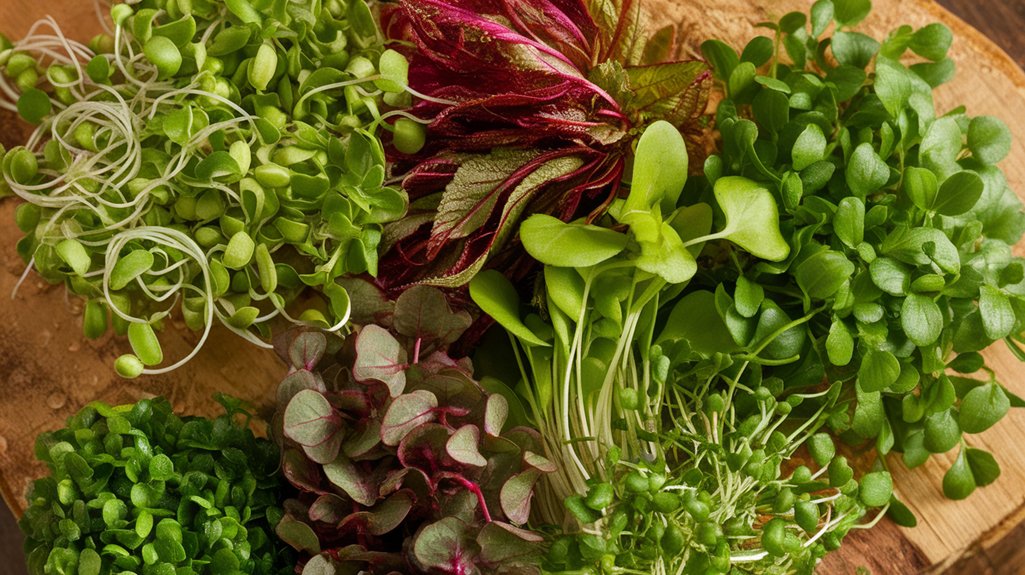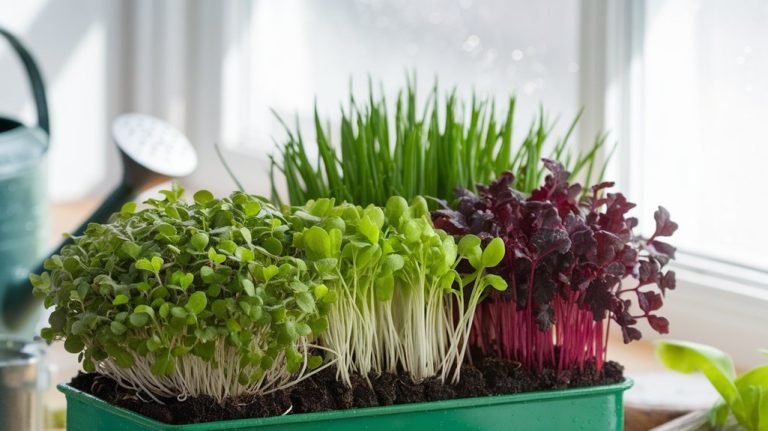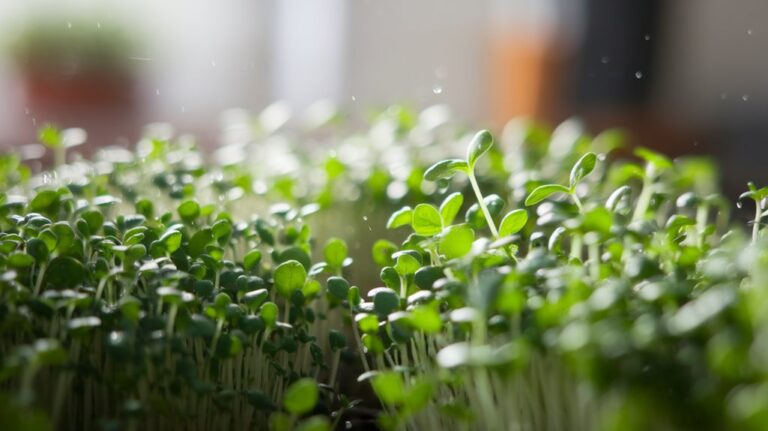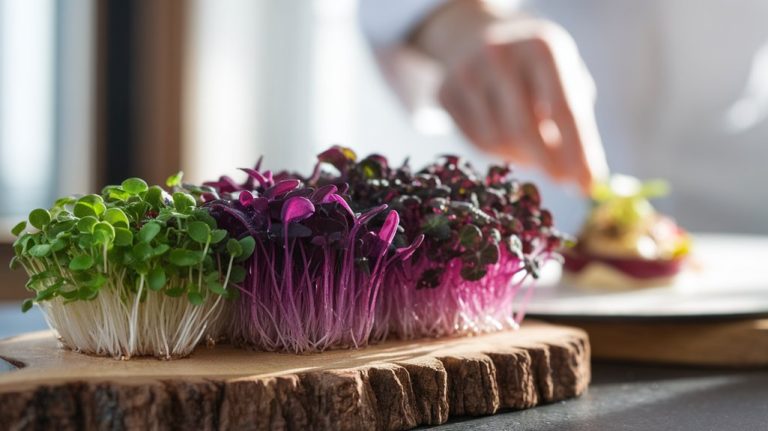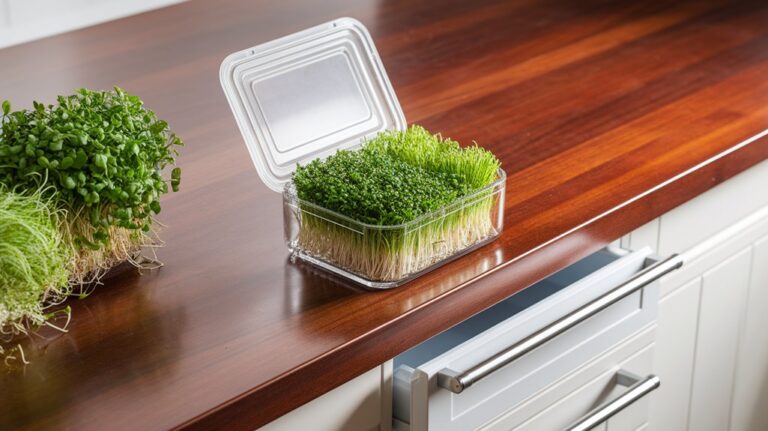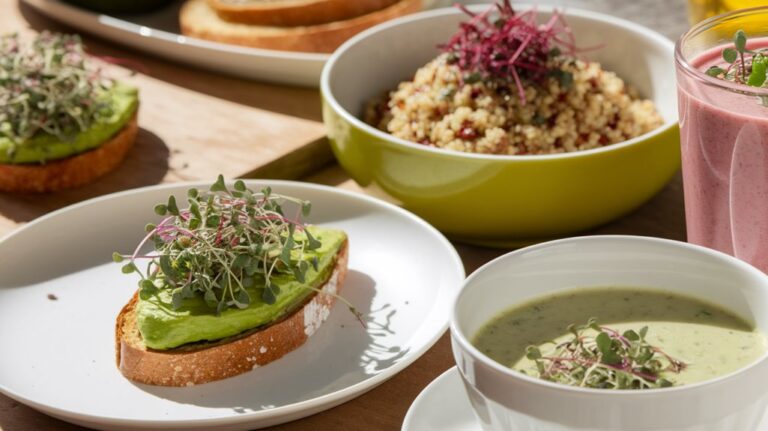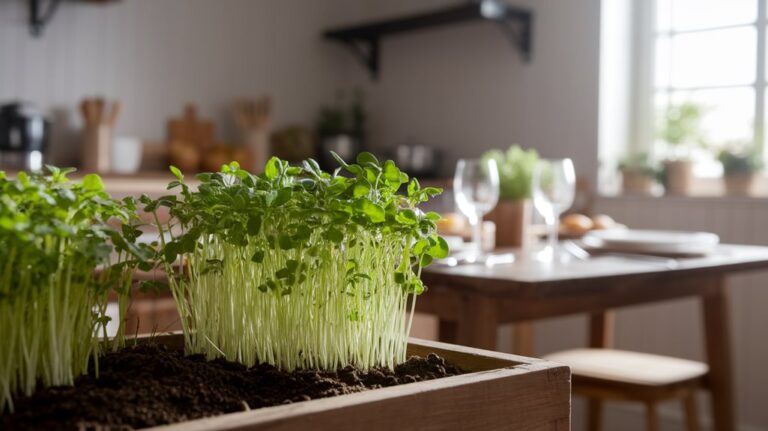Explore the Varieties: A Visual Guide to Popular Microgreens
I’m excited to introduce you to the vibrant world of microgreens! From the peppery kick of arugula to the sweet tenderness of pea shoots, each variety brings unique flavors and nutrients to your plate. Radish microgreens offer a spicy crunch, while sunflower microgreens add a nutty satisfaction. Don’t forget basil’s aromatic versatility or the earthy color of beet microgreens. Each type plays a role in enhancing your culinary creations. Stick around to uncover even more delightful options!
Key Takeaways
- Microgreens like arugula and radish offer distinct flavors, enhancing dishes with their peppery and spicy notes.
- Nutritional benefits vary, with options like broccoli and sunflower microgreens rich in vitamins A, C, and K.
- Easy to grow at home, most microgreens require minimal light and water for successful cultivation.
- Culinary versatility allows microgreens to be used in salads, sandwiches, soups, and smoothies.
- Visual appeal increases with the vibrant colors and textures of different microgreens, making dishes more enticing.
Arugula Microgreens: A Peppery Kick
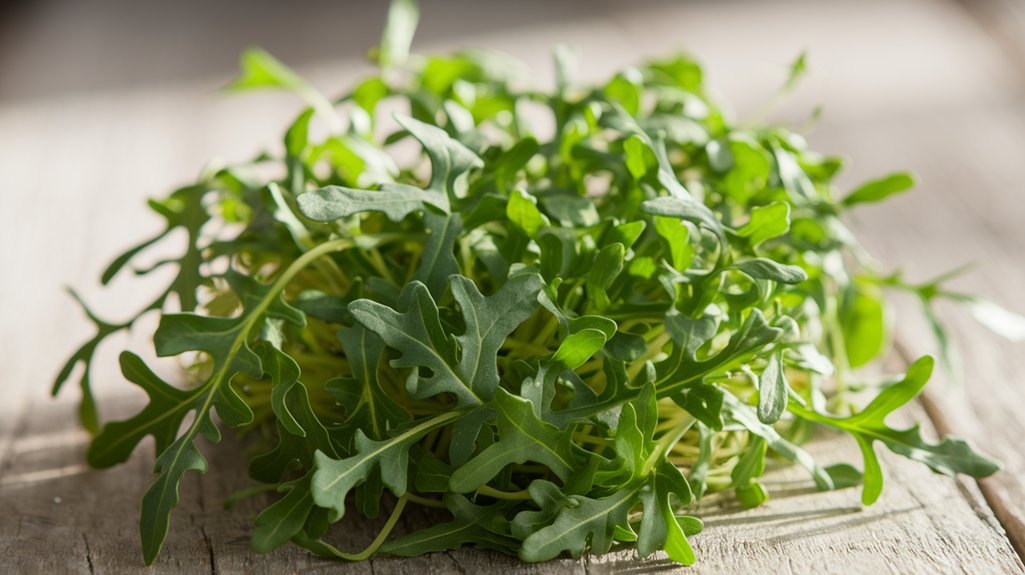
Arugula microgreens pack a peppery punch that can elevate any dish. I love incorporating them into my salads, sandwiches, and even as a garnish for soups. Their bold flavor adds a delightful kick, making them a favorite in my kitchen.
Not only do they taste great, but they’re also packed with nutrients. Rich in vitamins A, C, and K, arugula microgreens contribute to a well-rounded diet.
I often find them easy to grow at home, requiring just a bit of light and water. Whether you’re a seasoned chef or a home cook, these tiny greens can transform your meals.
Give them a try, and I bet you’ll find that arugula microgreens are a must-have in your culinary arsenal!
Pea Shoots: Sweet and Tender Delights
When you bite into pea shoots, you’ll discover a delightful sweetness that can brighten up any dish.
These vibrant, tender greens are a true treat, offering a unique flavor profile that’s both fresh and subtle. I love tossing them in salads, where they add a gentle crunch and a pop of color.
They’re also fantastic as a garnish on soups or sandwiches, elevating the presentation and taste.
Growing pea shoots is simple, too! Just plant them in soil or a growing tray, and within weeks, you’ll have a harvest of these delicious microgreens.
Plus, they’re packed with nutrients, making them a healthy addition to your meals.
If you haven’t tried them yet, you’re missing out on a culinary gem!
Radish Microgreens: Spicy and Crunchy Flavor
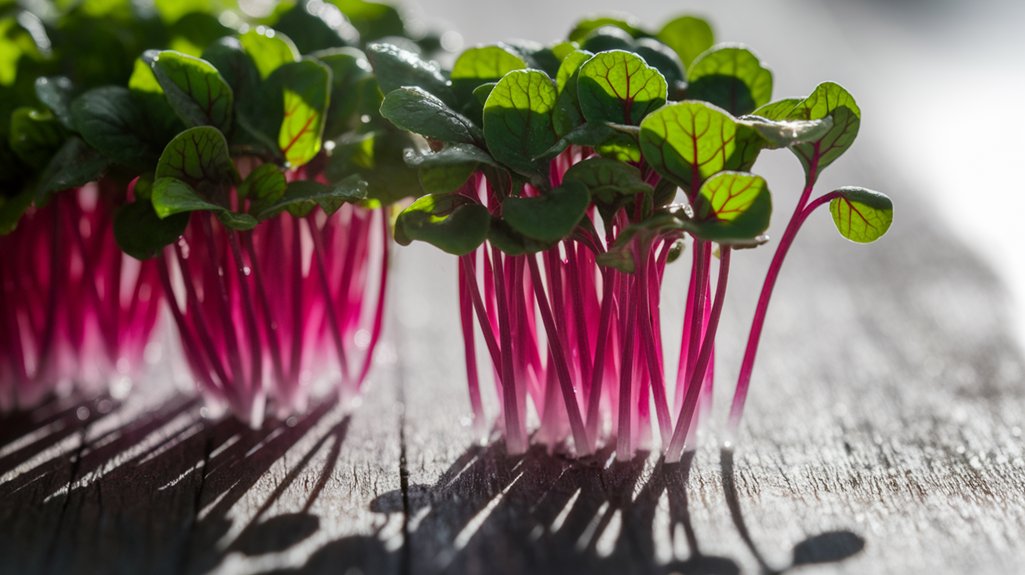
I love incorporating radish microgreens into my meals for their spicy, crunchy flavor and impressive health benefits.
They’re incredibly easy to grow at home, making them a perfect choice for anyone looking to add a burst of freshness to their dishes.
Let’s explore how these vibrant greens can enhance both your health and your culinary creations!
Health Benefits of Radish
Radish microgreens pack a powerful punch when it comes to health benefits, thanks to their impressive nutrient profile.
I love incorporating these vibrant greens into my meals because they’re rich in vitamins A, C, and E, which support skin health and boost immunity. Their high antioxidant content helps fight free radicals, promoting overall well-being.
Plus, radish microgreens are a fantastic source of minerals like potassium and calcium, essential for heart and bone health. Their spicy flavor not only adds zest to dishes but also stimulates digestion.
When I sprinkle them on salads or sandwiches, I know I’m nourishing my body while enjoying a burst of flavor. These tiny greens truly make a big impact on my health!
Growing Radish Microgreens Easily
Growing radish microgreens is surprisingly easy and rewarding, making them a perfect choice for both beginner and seasoned gardeners.
All you need are radish seeds, a shallow container, and potting soil. I start by filling the container with soil, then sprinkle the seeds evenly across the surface. Cover them lightly with more soil, and gently mist it with water.
Keeping the soil moist is key, so I check daily. In just 5 to 10 days, I see vibrant green sprouts emerging.
Once they reach about two inches tall, I harvest them by cutting just above the soil line. Their spicy, crunchy flavor adds a delightful kick to salads and sandwiches, making my efforts totally worth it!
Culinary Uses for Radish
While exploring the culinary world, you’ll discover that radish microgreens offer a unique combination of spicy and crunchy flavors that can elevate a variety of dishes.
I love adding them to salads for an extra kick or using them as a vibrant garnish on soups. Their peppery taste complements sandwiches beautifully, and they work wonders in tacos, providing a fresh contrast to rich fillings.
You can even blend them into pesto or incorporate them into smoothies for a nutrient boost. When paired with grilled meats or roasted vegetables, their bold flavor shines through.
Whether you’re an experienced chef or a home cook, radish microgreens are an easy way to bring excitement to your meals. Give them a try!
Sunflower Microgreens: Nutty and Satisfying
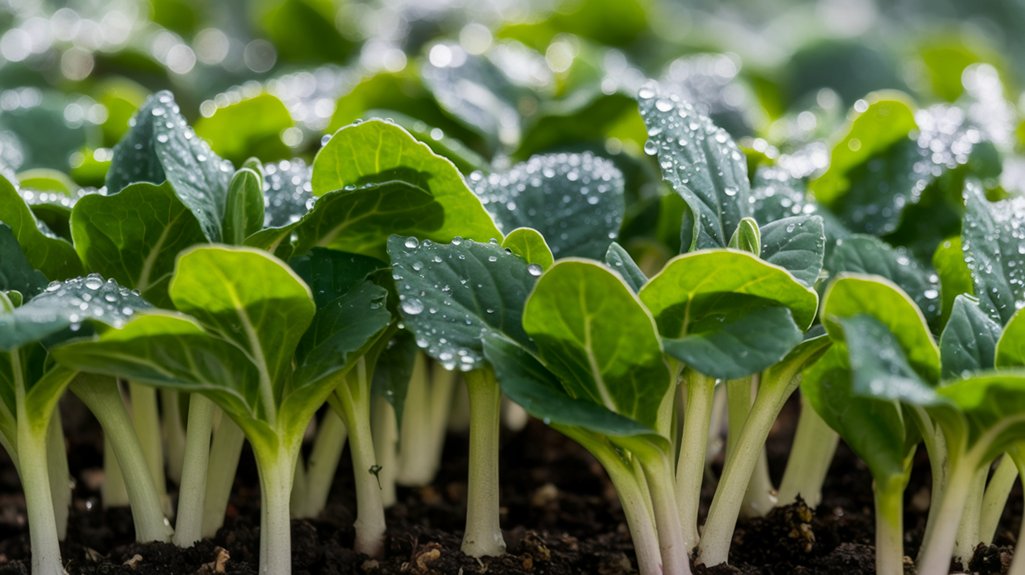
Sunflower microgreens are a delightful addition to any garden or kitchen, offering a nutty flavor that’s both satisfying and versatile.
I love incorporating them into salads, sandwiches, and wraps for an extra crunch. These tiny greens pack a nutritional punch, being rich in vitamins A, C, and E, along with essential minerals.
Plus, they’re easy to grow at home; just plant the seeds in a shallow tray with soil, water them, and watch them thrive in a sunny spot.
In about 7-14 days, you’ll have a fresh harvest ready to enjoy. The texture and taste elevate any dish, making sunflower microgreens a must-try for anyone looking to enhance their meals with a touch of freshness and flavor.
Basil Microgreens: Aromatic and Versatile
Basil microgreens are one of my favorite additions to any dish, thanks to their aromatic flavor and versatility.
Not only do they elevate the taste of meals, but they also pack a nutritional punch.
Let’s explore how to grow these little powerhouses and discover their culinary benefits!
Culinary Uses and Benefits
When I think about enhancing my dishes, basil microgreens often come to mind due to their aromatic and versatile nature.
These tiny greens add a fresh burst of flavor to salads, sandwiches, and even pasta. I love sprinkling them over pizza just before serving, as they bring an aromatic punch that elevates the entire dish.
Their delicate leaves can also be blended into pesto or used as a garnish for soups, adding both visual appeal and taste.
I’ve even experimented with them in smoothies, where their subtle flavor pairs nicely with fruits.
Whether I’m cooking or serving a simple snack, basil microgreens always find a way to enhance my culinary creations, making them a must-have in my kitchen.
Nutritional Value Overview
Microgreens, particularly basil, pack a surprising nutritional punch that often goes unnoticed.
These tiny greens aren’t just flavorful; they’re rich in vitamins A, C, and K, essential for maintaining our overall health. I’ve found that they contain high levels of antioxidants, which help combat oxidative stress in the body.
What’s more, basil microgreens are a great source of minerals like calcium, iron, and magnesium, contributing to bone and muscle health.
When I sprinkle them on salads or sandwiches, I’m not just enhancing the taste; I’m boosting my nutrition as well.
Including these microgreens in my diet has been a game-changer, proving that even small additions can make a significant impact on my overall wellness.
Growing Tips and Techniques
While growing basil microgreens might seem daunting at first, it’s actually quite simple and rewarding.
Start with high-quality seeds and a shallow container with drainage holes. I like to use a seedling mix for optimal growth. Sprinkle the seeds evenly over the soil, then gently press them down.
Water them lightly, keeping the soil moist but not soggy. Cover the container with a lid or plastic wrap to maintain humidity until the seeds germinate, which usually takes about 5 to 7 days.
Once they sprout, place them in a sunny spot or under grow lights.
Harvest your basil microgreens when they’re about 2 to 3 inches tall, and enjoy their aromatic flavor in salads, sandwiches, or as a garnish!
Beet Microgreens: Earthy and Colorful
Beet microgreens bring a splash of vibrant color and an earthy flavor to any dish. I love incorporating these tiny greens into my salads, sandwiches, and even as a garnish for soups.
Their deep red and green hues not only make meals visually appealing but also add a unique taste that’s slightly sweet and robust.
Growing beet microgreens is straightforward; they thrive in soil and require just a few days of care before they’re ready to harvest. You’ll notice their tender leaves and stems, which are perfect for snipping just above the soil line.
Plus, they’re packed with essential nutrients. Whether you’re a seasoned chef or a home cook, beet microgreens can elevate your culinary creations effortlessly.
Broccoli Microgreens: Nutrient Powerhouses
After exploring the vibrant world of beet microgreens, let’s turn our attention to another powerhouse in the microgreens category: broccoli microgreens.
These tiny greens pack a serious nutritional punch. I love how they’re rich in vitamins A, C, and K, along with essential minerals like calcium and iron.
What’s even more fascinating is their high concentration of sulforaphane, a compound linked to cancer-fighting properties. I often toss them into salads or blend them into smoothies for an added nutrient boost.
Their mild, slightly peppery flavor makes them versatile in various dishes. Whether you’re a seasoned chef or a kitchen novice, incorporating broccoli microgreens can elevate your meals while enhancing your health.
Trust me, you won’t want to miss out on these little gems!
Cilantro Microgreens: Fresh and Zesty
When I think of adding a burst of flavor to my dishes, cilantro microgreens immediately come to mind. These tiny greens pack a fresh, zesty punch that elevates everything from tacos to salads.
Their vibrant green leaves not only enhance the visual appeal of my meals but also infuse them with a unique, aromatic taste that’s hard to resist. I love tossing cilantro microgreens into my salsa or using them as a garnish for soups.
They’re incredibly easy to grow, requiring just a little sunlight and water. Plus, they’re a fantastic source of vitamins A, C, and K, making them both delicious and nutritious.
If you haven’t tried them yet, you’re missing out on a delightful culinary experience!
Mustard Microgreens: Bold and Fiery Taste
Mustard microgreens bring a bold, fiery taste that can transform any dish into a flavor explosion. I love adding them to my meals for that extra kick.
Their peppery flavor isn’t only delicious but also packs a nutritional punch. Here’s what makes mustard microgreens a must-try:
- Versatile: They can enhance salads, sandwiches, or even soups.
- Nutrient-rich: Packed with vitamins A, C, and K, they’re great for your health.
- Easy to grow: I’ve found they sprout quickly, making them perfect for home gardening.
Whether you’re looking to spice up your cooking or boost your nutrient intake, mustard microgreens are an excellent choice.
Give them a try and enjoy the fiery goodness!
Frequently Asked Questions
How Do I Store Microgreens for Maximum Freshness?
To store microgreens for maximum freshness, I usually place them in a damp paper towel inside a breathable container.
I avoid sealing them too tightly, as they need some air circulation. Keeping them in the refrigerator helps maintain their crispness, and I try to use them within a week for the best flavor and texture.
If I notice any wilting, I mist them lightly to perk them up again.
Can I Grow Microgreens Indoors Without Sunlight?
Yes, you can definitely grow microgreens indoors without direct sunlight!
I’ve had great success using grow lights, which provide the necessary spectrum for healthy growth. I set up my lights a few inches above the seedlings and keep them on for about 12-16 hours a day.
It’s amazing to see how quickly they thrive! Just make sure to monitor moisture levels, and you’ll have fresh microgreens in no time.
Are Microgreens Suitable for People With Allergies?
I’ve found that microgreens can be a great option for people with allergies, but it depends on the specific type.
Some varieties, like radish or mustard greens, might trigger reactions in sensitive individuals due to their strong flavors.
However, many others, such as sunflower or pea shoots, are generally safe.
I always recommend consulting with a healthcare professional before introducing any new foods, especially if you have known allergies.
What Are the Best Growing Mediums for Microgreens?
When I grow microgreens, I’ve found that the best growing mediums include soil, coconut coir, and hydroponic mats.
Soil gives nutrients, while coconut coir offers excellent moisture retention and is eco-friendly.
Hydroponic mats, on the other hand, provide a clean, soil-less option that promotes healthy growth.
Each medium has its perks, so I often experiment to see which works best for the specific microgreens I’m cultivating.
Happy growing!
How Long Do Microgreens Typically Take to Grow?
Microgreens usually take about 7 to 21 days to grow, depending on the variety.
I’ve found that leafy greens like arugula sprout quickly, often within just a week, while herbs like basil might take a bit longer.
It’s fascinating to watch them develop, and I recommend checking daily for that vibrant color and tender texture.
Once they’re ready, you’ll enjoy the fresh flavors they bring to your meals!
Conclusion
In exploring the vibrant world of microgreens, I’ve discovered that each variety brings its own unique flavor and character to the table. From the peppery kick of arugula to the earthy notes of beet microgreens, there’s a delightful option for every palate. Incorporating these tiny greens into your meals not only enhances taste but also boosts nutrition. So, why not experiment with these little powerhouses and elevate your dishes? Your taste buds will thank you!

